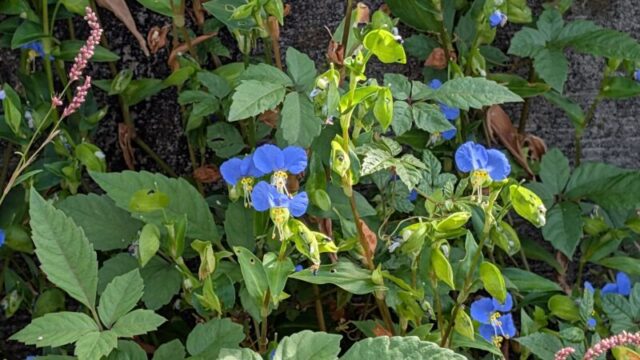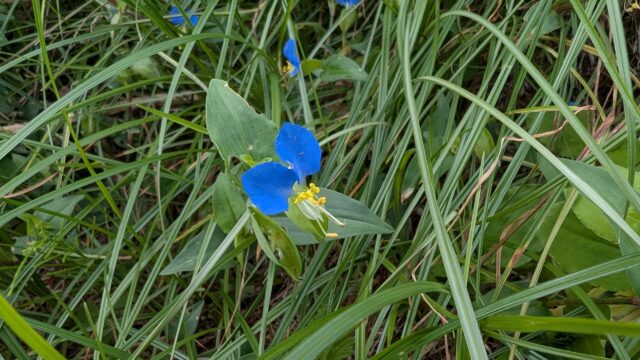The dayflower, known as tsuyukusa in Japanese, is a delicate wildflower that has captured the hearts of Japanese people for over 1,300 years. With its striking blue petals that bloom for only a single morning, this humble plant embodies the Japanese aesthetic of fleeting beauty. Beyond its ephemeral charm, the dayflower holds deep cultural significance in Japan, having been featured in ancient poetry, used in traditional art, and celebrated as a symbol of transience.
This article explores the botanical characteristics, cultural heritage, and contemporary appreciation of this remarkable blue wildflower from Japan.
What is Dayflower (Tsuyukusa)?
The dayflower, scientifically known as Commelina communis, is an herbaceous annual plant belonging to the Commelinaceae family. Native to East Asia, particularly Japan, China, and parts of Southeast Asia, this wildflower has naturalized in many regions around the world.
The plant’s scientific name has an interesting origin. Swedish botanist Carl Linnaeus named the genus Commelina in the 18th century to honor Dutch botanists Jan and Caspar Commelijn. The flower’s two large, showy blue petals were chosen to symbolize these two renowned botanists, while the smaller, often inconspicuous third petal represented a lesser-known third member of the family.
The English common name “dayflower” perfectly captures the plant’s most distinctive characteristic: each blossom opens in the early morning and withers by midday or early afternoon, lasting for just one day.
Distinctive Features of Dayflowers

Appearance and Flower Structure
Dayflowers are easily recognizable by their unique floral structure. Each flower displays two prominent, bright blue petals positioned at the top, while a third, much smaller white petal sits below. The flowers measure approximately 1 to 1.5 inches across and feature bright yellow stamens that create a striking contrast against the blue petals.
The plant itself has a sprawling growth habit. It can grow upright to about 1 to 3 feet in height or spread along the ground like a vine, extending up to 10 feet across. The stems are fleshy and succulent, with a characteristic swelling at the nodes where they can root when touching the ground.
The leaves are broadly lance-shaped, ranging from 3 to 6 inches in length, with parallel veins running across them. They are hairless and clasp the stem at their base, providing structural support for the spreading plant.
Blooming Season and Daily Cycle
In Japan, dayflowers typically bloom from June through September, with peak flowering occurring during the summer months. The timing aligns with the rainy season and warm weather, when these moisture-loving plants thrive.
The daily cycle of the dayflower is remarkably precise. Flowers open in the early morning hours, often before dawn, displaying their vibrant blue petals to attract pollinators. As the day progresses and temperatures rise, the petals begin to wilt. By noon or early afternoon, the flowers have completely closed and begun to deteriorate, leaving behind only the developing seed capsule.
This ephemeral nature is not merely decorative but serves an evolutionary purpose. The flower’s brief lifespan concentrates pollinator activity during cooler morning hours when both pollinators and plants are most active.
Natural Habitat and Growing Conditions
Where Dayflowers Grow in Japan
Throughout Japan, dayflowers can be found in a variety of environments. They commonly appear along roadsides, in disturbed areas, at the edges of cultivated fields, and in shaded woodland margins. The plants favor partially shaded locations where they receive dappled sunlight rather than intense direct sun.
In urban and suburban settings, dayflowers often emerge in garden edges, along pathways, and in any moist, sheltered spot where seeds have found suitable conditions. Their ability to thrive in human-modified landscapes has made them a familiar sight across the Japanese archipelago.
Preferred Growing Environment
Dayflowers demonstrate specific environmental preferences that contribute to their success:
Moisture requirements: These plants thrive in consistently moist to mesic conditions. They prefer well-drained yet moisture-retentive soil and are often found near water sources or in areas that receive regular rainfall.
Light conditions: While tolerant of full sun in cooler climates, dayflowers perform best in partial shade to light shade, particularly in Japan’s hot summers. The shade helps prevent the delicate flowers from wilting too quickly.
Soil preferences: The plants favor fertile, loamy soil that is slightly sandy. They are adaptable to various soil types but perform best in nutrient-rich conditions with good drainage.
Propagation: Dayflowers reproduce both by seed and vegetatively. The plants can root at stem nodes where they touch the ground, allowing them to spread and form colonies. Each seed capsule contains multiple seeds that can remain viable in the soil for extended periods.
Cultural Significance in Japanese Tradition
The Origin of the Name “Tsuyukusa”
The Japanese name “tsuyukusa” (露草) carries poetic meaning that reflects the flower’s ephemeral nature. The name combines “tsuyu” (露), meaning “dew,” and “kusa” (草), meaning “grass” or “herb.” This name evokes the image of morning dew—transient, delicate, and beautiful.
The association with dew perfectly captures the flower’s brief morning appearance, as fleeting and precious as dewdrops that vanish when touched by sunlight. This imagery deeply resonates with Japanese aesthetic sensibilities, particularly the concept of “mono no aware,” an appreciation for the impermanence of beauty.
Interestingly, there is an alternative theory about the name’s origin. In ancient times, the plant was called “tsukikusa” (月草), where “tsuki” relates to the verb “tsuku” (着く), meaning “to attach” or “to dye.” This naming may reference the plant’s traditional use in fabric dyeing, as the flower’s blue pigment could be transferred by rubbing petals onto cloth.
Dayflowers in Japanese Literature and Art
The dayflower holds a treasured place in Japanese literary and artistic traditions dating back over a millennium.
Poetry and Literature: The plant appears in the Manyoshu, Japan’s oldest collection of poetry compiled in the 8th century. In these ancient poems, the dayflower (referred to as “tsukikusa”) served as a poignant metaphor for fleeting love and the transience of beauty. Poets compared the fast-fading blue dye from the flowers to love affairs that might not endure, creating imagery that still resonates today.
The ephemeral nature of the dayflower made it a perfect symbol in waka poetry for expressing themes of impermanence, unrequited love, and the bittersweet beauty of moments that cannot last.
Ukiyo-e and Traditional Art: Perhaps the most significant artistic application of dayflowers was in ukiyo-e woodblock printing. During the 18th and early 19th centuries, before the development of permanent blue pigments, dayflower dye was used in Japanese printmaking, particularly for creating a paper called “aogami” or “boshigami.”
This special paper, manufactured primarily in Yamada village in Shiga Prefecture, was treated with dayflower juice to create a blue pigment used for preliminary sketches and underdrawing in woodblock prints. Artists would outline their designs with this blue ink, which would be covered by permanent colors during the final printing process.
Before the introduction of imported Prussian Blue to Japan, dayflower blue was one of the few available blue pigments for Japanese artists, making it invaluable to the ukiyo-e tradition that would later inspire Western Impressionist painters.
Traditional Uses in Japan
Beyond artistic applications, dayflowers have served practical purposes in Japanese culture:
Natural Dye: The flowers were traditionally used to create a beautiful but impermanent blue dye for textiles. While the color was stunning when freshly applied, it faded relatively quickly, limiting its use to temporary applications or underdrawings.
Cultural Symbolism: The plant’s ephemeral flowers became a symbol of fleeting beauty in Japanese culture, embodying the aesthetic principle of valuing things precisely because they do not last. This philosophy appears throughout Japanese art, literature, and cultural practices.
Seasonal Marker: The appearance of dayflowers in summer gardens and along pathways served as a natural calendar, marking the progression of the warm season and the approaching autumn.
Dayflowers in the Garden
Growing Dayflowers
While sometimes considered a weed in cultivated areas, dayflowers can be appreciated as charming additions to naturalistic gardens, particularly for those who value native or naturalized plants.
Starting from Seed: Dayflower seeds can be collected from mature seed capsules in late summer or early autumn. Each capsule typically contains two to four seeds. Seeds can be sown directly in the garden in spring after the last frost, or started indoors and transplanted once seedlings are established.
Environmental Requirements: To successfully grow dayflowers, provide the following conditions:
- Moisture: Consistent moisture is essential. Water regularly during dry periods, especially in summer.
- Light: Partial shade is ideal, though plants will tolerate full sun in cooler climates or with adequate moisture.
- Soil: Fertile, well-draining soil with good organic content supports healthy growth.
- Space: Allow room for spreading, as these plants can cover considerable ground.
Maintenance: Dayflowers require minimal maintenance once established. They are relatively pest-resistant and disease-free. However, be aware that they can spread vigorously and may need to be managed in formal garden settings.
Important Consideration: In some regions outside Japan, dayflowers are considered invasive plants due to their rapid spread and ability to form dense colonies that exclude native species. Before planting, check local regulations and consider the ecological impact in your area.
Companion Planting and Garden Design
Dayflowers work well in several garden contexts:
Naturalistic Gardens: These plants shine in gardens that embrace a wilder, more naturalistic aesthetic. Pair them with other moisture-loving plants like hostas, ferns, and other shade-tolerant perennials.
Rain Gardens: The moisture requirements of dayflowers make them suitable for rain gardens or areas that receive periodic flooding but drain well.
Shaded Groundcover: In partially shaded areas, dayflowers can serve as an attractive groundcover, though their annual nature means they will die back in winter in temperate climates.
Morning Gardens: Create a “morning garden” featuring plants that bloom early in the day, highlighting the dayflower’s unique characteristic of opening at dawn.
Pollinator Gardens: The morning flowers attract early-rising pollinators, including bees and butterflies, making them valuable additions to pollinator-friendly gardens.
Similar Species and Identification
Several related species can be confused with the Asian dayflower:
| Feature | Asiatic Dayflower (Commelina communis) | Slender Dayflower (Commelina erecta) | Spiderwort (Tradescantia spp.) |
|---|---|---|---|
| Petal Color | Two blue petals, one white | Blue petals with yellow center spot | Three equal purple/blue petals |
| Growth Habit | Spreading, often prostrate | More upright | Upright, clumping |
| Leaf Arrangement | Alternate | Alternate | Alternate |
| Native Range | East Asia | North America | North and South America |
| Distinctive Features | Smooth stems and leaves | Often hairy | Flowers last longer than one day |
The key to identifying true dayflowers lies in observing the two large blue petals contrasting with a smaller white petal, the flower’s one-day lifespan, and the smooth, succulent stems with swollen nodes.
Conclusion
The dayflower stands as a testament to the Japanese appreciation for fleeting beauty and the deep connection between nature and culture. For more than thirteen centuries, this modest blue wildflower has inspired poets, served artists, and delighted observers with its brief but luminous morning display.
Whether encountered along a rural pathway, featured in classical poetry, or carefully tended in a contemporary garden, the dayflower continues to embody profound aesthetic and philosophical principles. Its ephemeral blooms remind us that beauty need not be permanent to be meaningful, and that there is particular poignancy in appreciating something precisely because it cannot last.
For gardeners and nature enthusiasts outside Japan, cultivating dayflowers offers an opportunity to connect with this rich cultural heritage while enjoying a charming and resilient plant. The sight of those brilliant blue petals opening in the early morning light carries with it centuries of tradition, a living link to ancient poems and traditional arts, and a gentle reminder to appreciate the transient beauty that surrounds us each day.
In the words evoked by the ancient Manyoshu poets, the dayflower teaches us that some of life’s most precious moments, like the flower’s brief bloom, are beautiful not despite their impermanence but because of it.


